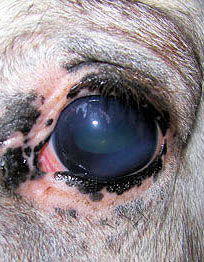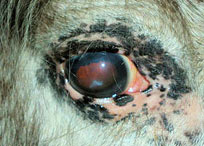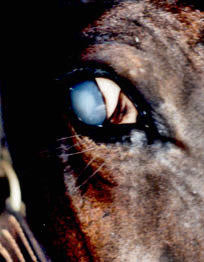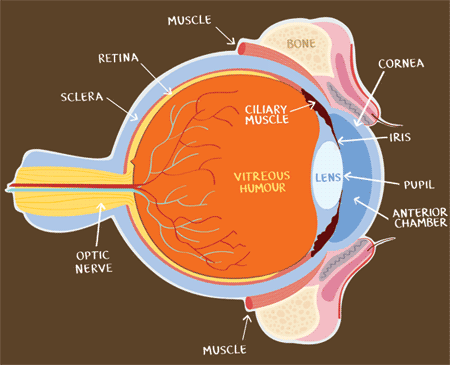Moon Blindness (Uveitis): How it Happens and How it Progresses
by Dr. Joseph Thomas
Printed in: Holistic Horse Magazine
Dec 08/Jan 09 Issue
Uveitis, commonly called “Moon Blindness,” can be found in many animals, including humans. Moon blindness in horses has been identified since the time of Alexander the Great when it was believed to be associated with changes of the lunar cycles, giving it the name still being commonly used today.
The medical term uveitis defines the disease as an inflammation [-itis] of the uvea of the eye. The uvea is the membrane that surrounds the eye, serving as an immunologic barrier to protect the sensitive tissue, inner chambers, and surfaces of the eye from pathogens carried through the blood. Inflammation disrupts this barrier and is the instrument that progresses this disease from initial damage to blindness.
How does this happen?
Uveitis can be caused by:
- blunt or penetrating trauma to the eye
- corneal ulceration
- parasitic infiltration
- numerous systemic infection
If there is trauma to the eye and a cut or scratch occurs, this can be enough to set off a local infection leading to unchecked inflammation. Corneal ulcers caused by fungi or bacteria can reach deep into the cornea and induce uveitis. Of the systemic diseases implicated in uveitis, infections of the Streptococcus equi (strangles) and Leptospira interrogans (bacterial) occur most commonly. Autoimmune diseases can also be associated with uveitis onset; this paradoxical disease process is when the immune system attacks tissues of its own body as if they were pathogens.
Early uveitis is characterized by painful spasms of the smooth muscles (ciliary muscles) in the iris. The result of these spasms is a constriction of the pupil and an abnormal intolerance of light (photophobia). The spasms of the ciliary muscles will cause constriction of the pupil even in the dark when the horse’s pupil would normally be dilated to allow as much light as possible. Early signs will be tearing, squinting, and high sensitivity to light. There may also be swelling of the eyelid at this early uveitis stage. A subtle but noticeable opaqueness or cloudiness within the eye can be seen, a haze referred to as the “aqueous flare.”
If you suspect that your horse’s pupil is constricted, gently and slowly trace a penlight across your horse’s pupil and look for changes in pupil size and shape. Do this in a place that is darkened so that there is reason for the pupil size to respond.
As with most diseases, treatment during the early stages is optimal to stop further progression into the eye.



Disease Progression
As uveitis increases in severity, the uvea becomes increasingly unable to protect the eye. White blood cells leak into and settle in the anterior eye chamber (behind the cornea and in front of the lens). This is what creates the aqueous flare. An element of a blood-clot known as “fibrin” can build up in the anterior chamber and cause scarring within the eye. This can attach the lens to the iris, preventing it from opening under dark conditions. A subtle sign of the iris darkening gives the visual appearance of a chocolate color when looking into the eye.
As the disease progresses, cataracts may form, glaucoma can develop, the eye becomes misshapen, and the retina may be affected by lesions. By this point, visual impairment is certain.
It is important to understand that horses can learn to move about in their worlds with partial or complete blindness in one eye.
 Pharmaceutical Intervention
Pharmaceutical Intervention
At the first notice of any of the uveitis signs contact a veterinarian who can do a thorough ophthalmic examination. This is essential for an accurate diagnosis.
Two main drugs used by veterinarians for the treatment of uveitis are atropine and corticosteroids. Atropine is used to paralyze the muscles that cause the muscle spasms to remove the constriction of the pupil. Atropine is also used in the hope of preventing corneal scarring. Paralyzing these muscles means that your horse’s eye will be dilated until the drug is stopped or its effects have diminished. This means your horse’s eye will remain dilated and unable to respond to changes in light intensity or focal length, meaning the visual world will be blurry and sometimes painfully bright.
Corticosteroids are given to horses due to their anti-inflammatory properties. The side effect is that they will deplete your horse’s immune system. This occurs whether the corticosteroids are given topically or systemically; the location and strength of dosage are important factors in how much they deplete the immune system. For horses who have Equine Metabolic Syndrome or have had a laminitic episode, there is a distinct possibility of an acute laminitic event from corticosteroid use.
Natural Intervention
Any natural path you consider needs to be based on a precise and sophisticated treatment strategy. Uveitis is a complicated and severe eye disease. All-purpose supplements that support the immune system or improve eye function are not designed to deal with the many aspects of this disease and will likely prove to be of little benefit. Unless the runaway inflammatory component is stopped there will be no hope for recovery.
Whatever course you choose, consider that it must deal with the following aspects to effectively alter the course of this disease:
- dampen the inflammatory process
- assist in healthy blood irculation so that the cornea, iris, inner chambers, and retina receive adequate nutrition
- reduce the spasms of the ciliary muscles
- promote cellular recovery
Joseph Thomas, PhD, has been a practitioner, teacher, and consultant of Chinese medicine for 25 years. Prior to his commitment to Chinese medicine, Dr. Thomas was on the research staff at the Massachusetts Institute of Technology (MIT) engaged in medical research. He united these two skills with his life-long love of horses and developed For Love of the Horse, a Natural Horse Health Care company providing Herbal Solutions, precisely formulated by Dr. Thomas, for a wide range of horse health issues.
Author acknowledgements: This article would not be possible except for the skillful editorial insight of my wife, and general manager of For Love of the Horse, Crystal Leaman. would also like to thank Valerie Burgess, our graphic arts extraordinaire, for the excellent illustration of the eye.







